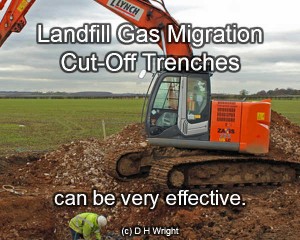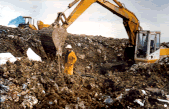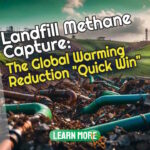 Landfill gas cut-off Trenches can be successfully used for landfill gas migration control where landfill gas is escaping from a landfill underground and threatening to enter properties, or causing the die-back of trees and vegetation on the landfill perimeter.
Landfill gas cut-off Trenches can be successfully used for landfill gas migration control where landfill gas is escaping from a landfill underground and threatening to enter properties, or causing the die-back of trees and vegetation on the landfill perimeter.
Landfill Gas Cut-Off Trenches
Landfill Gas Cut-Off Trenches can be a simple, and when designed correctly, also usually a reliable option for the remediation and prevention of landfill gas migration from unlined gassing landfills. The purpose of a Cut-Off Trench is to block the flow path for landfill gas to stop it passing out from the landfill in the ground, where it might:
- damage vegetation and crop growth;
- cause an explosion or asphyxiation risk.
What is a Landfill Gas Cut-Off Trench?
It usually comprises a trench which is backfilled with single size stone, to allow landfill gas to vent (flow) upwards and not continue horizontally through the ground. A non gas-permeable membrane (usually HDPE (high density polyethylene) or LLDPE (Linear Low Density Polyethylene) is usually placed on the slope of the trench remote from the landfill.
The depth of the trench and membrane must penetrate low enough into the ground to prevent the landfill gas flowing beneath the cut-off. It is usually extended downward to key into a low gas permeability soil or rock strata, or to 1 metre approximately below the lowest groundwater water level experienced at the location of the trench.
Landfill Gas Cut-Off Trenches are normally passively vented (no extraction pumping takes place).
Does it Need Maintenance?
Maintenance requirements will differ, but generally it is essential that the gravel at the top of the cut-off trench remains open to the atmosphere, and does not become covered over a period of time. This would inhibit natural “venting” and must be avoided. Ensuring that the top of the cut-off trench is achieved by regular inspection and maintenance to remove any material which falls or is washed onto the top of the cut-off trench.
Is the Top of a Cut-Off Trench Liable to be Hazardous?
If correctly designed by an expert, and accompanied by a rigorous site specific risk assessment, the trench will be designed on one of the following principles:
1. The top of the vent trench is left open so that free flow of air into the cut-off trench by natural convection will ensure that the air above the trench dissipates the landfill gas rapidly and that the gas concentration present (% age of the LEL (Lower Explosive Limit)) always stays well below a hazardous level at the surface. (This is the normal situation for landfills see the Waste ICoP at www.esauk.org )
 For this reason it is usually important that the whole of the trench surface remains free from obstruction, for the free venting of these gases. However, it may not be necessary to zone this as a hazardous zone under DSEAR/ATEX Directive requirements.
For this reason it is usually important that the whole of the trench surface remains free from obstruction, for the free venting of these gases. However, it may not be necessary to zone this as a hazardous zone under DSEAR/ATEX Directive requirements.
2. The top of the vent trench is covered and vented at a pipe or flu such that the landfill gas below the vent will be at or above the LEL. In this case a hazardous (explosive zone) will exist and will be hazardous requiring special attention. See the Waste ICoP at www.esauk.org
When are Landfill Gas Cut-Off Trenches Used?
They are often installed around old (unlined) domestic waste landfills when these are capped, or subsequently in the event that landfill gas migration becomes evident.
Landfill Gas Cut-Off Trenches are not generally used, nor should they be necessary for landfills designed to current EU, and most national standards worldwide. Good practice dictates that landfills must be lined, and that lining must exhibit a suitably low gas permeability. Furthermore, all UK landfills must be provided with actively pumped LFG extraction systems, to further minimise gas migration risk.
Landfill Gas Migration Problem? If you need assistance with a landfill gas problem we can recommend experienced landfill gas engineers that have designed and successfully installed many landfill gas Cut-Off Trenches, just go to our Contact Us page. For more information, fill in the form, or call us at the telephone number provided.
Landfill Gas migration is a serious matter. Landfill Gas migration has caused death. Ensure that landfill gas migration issues are treated seriously and resolved by experts.
Construction of Cut-Off Trenches can also be hazardous. Ensure full Risk Assessments are carried out and the resulting measures to ensure safety are rigorously applied.
Methane Emissions from Landfills: Problems and Solutions
Methane emissions from landfills significantly contribute to climate change due to their potent greenhouse effect. Capturing and utilizing landfill gas as energy, reducing organic waste, and enhancing recycling are vital solutions. Community engagement and effective policy regulations are key to mitigating these emissions and tackling global warming effectively…
Landfill Gas Pin Wells: A Low-Cost, High-Impact LFG Extraction Option
Discover the advantages of landfill gas pin wells, a cost-effective solution for efficient LFG extraction. Easier installation, lower costs, and increased gas capture make them ideal for sustainability. Learn how pin wells transform waste into energy, reducing emissions and supporting renewable projects across waste management facilities…
Landfill Methane Capture: The Global Warming Reduction “Quick Win” You've Never Heard Of
Concerned about the menacing effects of landfill gas on our environment? You're not alone, but it's not as bad as it might be where a landfill has a well-engineered Landfill Methane Capture system installed. In fact, we go so far as to say that landfill methane capture and utilisation is the global warming reduction “Quick […]
Landfill Gas Collection Systems Defined – UK Facts and Myths
Go no further to read all about landfill gas collection systems. LFG collection systems are defined in the next section, followed by a UK landfill gas collection history. Those are the facts, now for the myths! If you scroll further down on this page we explain some myths about Landfill Gas Collection Systems, and a truth. […]





![A landfill collection system shown in 3D cut-away style. By US EPA - LMOP (US EPA - LMOP) [Public domain], via Wikimedia Commons.](https://landfill-gas.com/wp-content/uploads/2018/11/512px-Landfill_gas_collection_system-150x150.jpg)



The opportunity to produce energy from waste is largely being squandered here, as up to 80% of the potential methane in waste is not used.
If more councils were prepared to invest in better facilities, Australians would benefit from less waste in landfill and more energy in our grids.
Even the by-product from using state-of-art processing methods can be used as a bio-fertiliser. http://theconversation.com/capturing-the-true-wealth-of-australias-waste-82644
Pingback: An Introduction to Landfill Gas Extraction Well Design